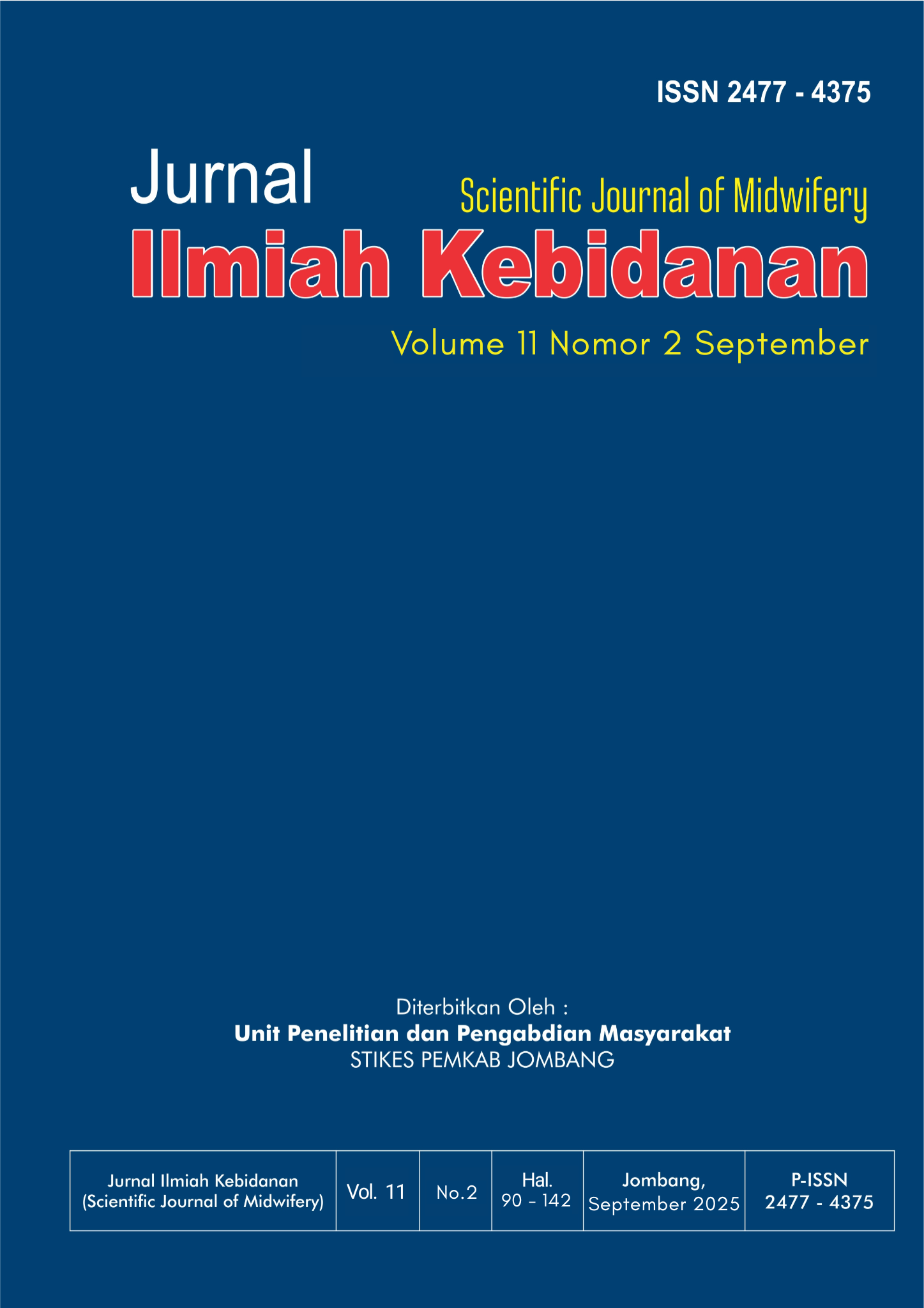HUBUNGAN PENGETAHUAN TERHADAP KEPATUHAN KONSUMSI TABLET TAMBAH DARAH (TTD) PADA REMAJA PUTRI DI MTs NU NEGARABATIN KOTAAGUNG BARAT KABUPATEN TANGGAMUS
The Relationship Between Knowledge and Compliance with Iron Supplement Tablet (TTD) Consumption in Adolescent Girls at MTS NU Negarabatin, West Kotaagung, Tanggamus Regency
DOI:
https://doi.org/10.33023/jikeb.v11i2.2706Keywords:
Knowledge, AdherenceAbstract
The prevalence of anemia according to the World Health Organization (WHO) in 2022, reached 50-65% worldwide, in Indonesia adolescent girls experienced anemia 18% in 2023, Lampung Province showed adolescents experiencing anemia 63% in 2023, in Tanggamus district as much as 8.7% and West Kotaagung District by 4.9% in 2023. One of the causes of anemia is iron deficiency, this can be prevented by giving blood supplement tablets in accordance. The dose given is one tablet every week. The purpose of this study was to determine the correlation between knowledge and adherence to the consumption of blood supplement tablets in adolescent girls at MTs NU Negarabatin West Kotaagung, Tanggamus District.
The research method used was quantitative research with a cross-sectional approach. The research was conducted at MTs NU Negarabatin. The population of this study were all adolescent girls totaling 60 people. The sample technique used was total sampling. Data collection using a questionnaire that has been tested for validity and reliability. Data analysis was univariate and bivariate using Fisher Exact Test.
The results showed that the knowledge of adolescent girls was mostly low, namely 36 adolescent girls (60.0%). Adherence to the consumption of blood supplement tablets in adolescent girls is not compliant, which amounted to 58 adolescent girls (96.7%). The Fisher Exact Test results obtained p-value = 0.156, so it was concluded that there was no correlation between knowledge and compliance with the consumption of blood supplement tablets at MTs NU Negarabatin. It is expected for teachers to provide support and for health workers to further increase socialization and counseling to adolescent girls about anemia and the importance of consuming blood supplement tablets
Downloads
References
Dinas Kesehatan, K. (2023). Pemerintah Provinsi Lampung Dinas Kesehatan (pp. 1–339).
Fauzia Nuraina, V., & Sulistyoningsih, H. (2023). Hubungan Antara Pengetahuan Gizi, Status Gizi Dan Kepatuhan Konsumsi Tablet Tambah Darah (Ttd) Dengan Kejadian Anemia Pada Remaja Putri Di Smk Al-Ishlah Singaparna Tahun 2023 the Relationship Between Nutritional Knowledge, Nutritional Status, and Adherenc. Journal of Midwifery and Public Health, 5(2), 1–18.
Fauziyah, et al. (2024). Hubungan Tingkat Pengetahuan Anemia Dengan Kepatuhan Konsumsi Tablet Tambah Darah Pada Remaja Putri Di Smpn 1 Kalijati. Medic Nutrica, 6(2), 25–31.
Hasana, U., Amelia, A. R., & Septiyanti. (2024). Faktor Yang Memengruhi Tingkat Kepatuhan Remaja Putri Dalam Mengomsumsi Tablet Tambah Darah. 5(5), 602–612.
Kemenkes RI. (2023). Buku Saku Pencegahan Anemia Pada Ibu Hamil Dan Remaja Putri. In IEEE Sensors Journal (Vol. 5, Issue 4). http://dx.doi.org/10.1016/j.snb.2010.05.051
Kementerian Kesehatan, R. (2023). Survei Kesehatan Indonesia Dalam Angka.
Nurjanah, A., & Azinar, M. (2023). Kepatuhan Konsumsi Tablet Tambah Darah Remaja Putri pada Sekolah Percontohan Kesehatan Reproduksi dan Seksualitas. HIGEIA (Journal of Public Health Research and Development), 7(2), 244–254. https://doi.org/10.15294/higeia.v7i2.64227
Pagiu, H. W., Suramas, L. Y., & Sriwahyuni. (2024). Hubungan Pengetahuan dan Dukungan Guru dengan Kepatuhan Mengonsumsi Tablet Tambah Darah (TTD) Pada Remaja Putri di SMAN 4 Tana Toraja. OBAT: Jurnal Riset Ilmu Farmasi Dan Kesehatan, 2(1), 223–236.
Ramlah, Ida, A. S., Saadong, D., & Sabur, F. (2022). Hubungan Pengetahuan Dan Sikap Dengan Kepatuhan Mengkonsumsi Tablet Fe Pada Remaja Putri Di Wilayah Kerja Puskesmas Minasa Upa Makassar. Jurnal Inovasi Penelitian, 3, 6.
Runiari, N., & Hartati, N. N. (2020). Pengetahuan Dengan Kepatuhan Minum Tablet Tambah darah Pada Remaja Putri. Jurnal Gema Keperawatan, 13(2), 103–110. https://doi.org/10.33992/jgk.v13i2.1321
Rusdiana, R., & Zubaidah, Z. (2024). Hubungan Pengetahuan dan Kepatuhan Mengkonsumsi Tablet Tambah Darah (Fe) dalam Pencegahan Anemia pada Remaja Putri. JoIN : Journal of Intan Nursing, 3(1), 1–8. https://doi.org/10.54004/join.v3i1.109
Sriwahyu, S., Astuti, W., Yuliastuti, E., Tunggal, T., & Kristiana, E. (2025). Hubungan Pengetahuan dan Sikap Remaja Putri Tentang Anemia Dengan Kepatuhan Minum Tablet Tambah Darah di SMPN 8 Banjarmasin. 1(8), 1215–1223.
Suharmanto, S., Mutmainnah, S., & Zuraida, R. (2023). Pengetahuan dan Sikap Berhubungan dengan Kepatuhan Mengonsumsi Tablet Tambah Darah pada Remaja Putri. Jurnal Penelitian Perawat Profesional, 5(3), 1321–1328
Wahyuningsih, A., & Rohmawati, W. (2020). Hubungan Pengetahuan Dengan Kepatuhan Konsumsi Tablet Tambah Darah Pada Remaja Putri Di SMP N 1 Karangnongko. INVOLUSI: Jurnal Ilmu Kebidanan, 10(1), 8–12. https://doi.org/10.61902/involusi.v10i1.115
Wati, E., Kariny, E. J. A., Besmaya, B. M., & Qurniasih4, N. (2024). Pengaruh Pemberian Buah Bit (Beta Vulgaris L) Terhadap PENGARUH Kadar Hemoglobin Pada Remaja Putri Dengan Anemia Di SMA Negeri Talang Padang.
WHO. (2021). World Health Organization. https://www.who.int/data/gho/data/themes/topics/anaemia_in_women_and_children
Published
How to Cite
Issue
Section
Authors who publish with Jurnal Ilmiah Kebidanan (Scientific Journal of Midwifery) agree to the following terms:
- Authors retain copyright and grant Jurnal Ilmiah Kebidanan (Scientific Journal of Midwifery) the right of first publication with the work simultaneously licensed under a Creative Commons Attribution 4.0 International License that allows others to remix, adapt and build upon the work with an acknowledgment of the work's authorship and of the initial publication in Jurnal Ilmiah Kebidanan (Scientific Journal of Midwifery).
- Authors are permitted to copy and redistribute the journal's published version of the work (e.g., post it to an institutional repository or publish it in a book), with an acknowledgment of its initial publication in Jurnal Ilmiah Kebidanan (Scientific Journal of Midwifery).







 This journal (p-ISSN : 2477-4375; e-ISSN : 2477-4383) is licensed under a
This journal (p-ISSN : 2477-4375; e-ISSN : 2477-4383) is licensed under a 